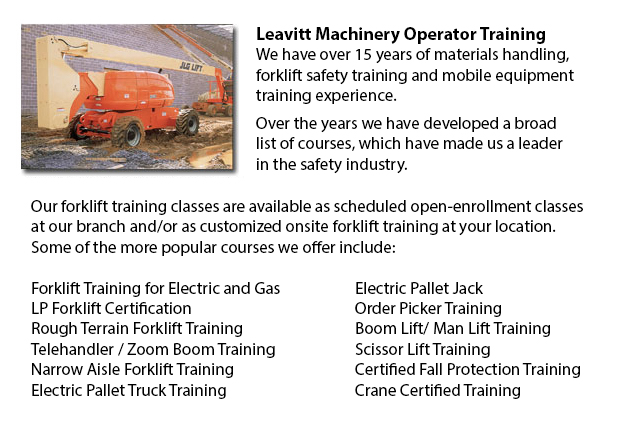
Aerial Platform Training Prince Albert - Aerial forklifts can be used to accomplish several different duties executed in hard to reach aerial spaces. Some of the duties associated with this type of jack include performing routine preservation on buildings with high ceilings, repairing telephone and utility cables, raising heavy shelving units, and pruning tree branches. A ladder could also be utilized for some of the aforementioned jobs, although aerial lifts provide more security and stability when properly used.
There are a variety of distinctive models of aerial forklifts accessible, each being able to perform moderately different jobs. Painters will often use a scissor lift platform, which is able to be utilized to get in touch with the 2nd story of buildings. The scissor aerial platform lifts use criss-cross braces to stretch out and lengthen upwards. There is a table attached to the top of the braces that rises simultaneously as the criss-cross braces raise.
Bucket trucks and cherry pickers are another type of aerial hoist. They possess a bucket platform on top of an elongated arm. As this arm unfolds, the attached platform rises. Forklifts use a pronged arm that rises upwards as the handle is moved. Boom lift trucks have a hydraulic arm which extends outward and lifts the platform. All of these aerial platform lifts have need of special training to operate.
Through the Occupational Safety & Health Association, also called OSHA, instruction courses are on hand to help make certain the workforce satisfy occupational standards for safety, machine operation, inspection and upkeep and machine weight capacities. Employees receive qualifications upon completion of the course and only OSHA qualified employees should drive aerial platform lifts. The Occupational Safety & Health Organization has formed rules to uphold safety and prevent injury while utilizing aerial lift trucks. Common sense rules such as not using this machine to give rides and ensuring all tires on aerial hoists are braced so as to hinder machine tipping are referred to within the guidelines.
Sadly, figures show that in excess of 20 operators die each year when working with aerial lifts and 8% of those are commercial painters. Most of these mishaps are due to inappropriate tire bracing and the hoist falling over; for that reason a lot of of these deaths were preventable. Operators should ensure that all wheels are locked and braces as a critical safety precaution to prevent the instrument from toppling over.
Other suggestions involve marking the surrounding area of the machine in an obvious manner to protect passers-by and to ensure they do not come too close to the operating machine. It is crucial to ensure that there are also 10 feet of clearance between any electrical lines and the aerial hoist. Operators of this equipment are also highly recommended to always wear the proper safety harness while up in the air.
-
Zoom Boom Training Prince Albert
Zoom Boom Training Prince Albert - Zoom Boom Training focuses on correctly training potential operators on variable reach forklifts. The training objectives include gaining the understanding of the machine's physics and to be able to define the job o... More -
Bucket Truck Training Prince Albert
Bucket Truck Training Prince Albert - The Vehicle-Mounted Aerial Work Platform or also called bucket truck training program is intended to reduce the chance of incident and personal injury when working with or in close proximity to bucket trucks by e... More -
Aerial Lift Training Prince Albert
Aerial Lift Training Prince Albert - An aerial work platform is a mechanized access platform. This device provides access to otherwise not accessible places for people or equipment. Likewise called an aerial device or elevating work platform, the mac... More -
Overhead Crane Ticket Prince Albert
Overhead Crane Ticket Prince Albert - The overhead crane is a common heavy machinery utilized in industrial settings. This particular machine is known as a bridge crane and comprises parallel runways spanned by a traveling bridge. The hoist is the co... More -
Scissor Lift Ticket Prince Albert
Scissor Lift Ticket Prince Albert - Scissor lifts have greatly benefited construction operations because the task that used to need a lot of effort and lots of people, can now be accomplished using the scissor lift and just one individual, the operat... More -
Manlift Training Prince Albert
Manlift Training Prince Albert - Different manlift training programs include the review and content of manlift devices. An essential part of the program is the practicum where students demonstrate their knowledge and practical ability to operate the... More -
Skid Steer Loader Training in Prince Albert
The engine powered skid-steer loader consists of a rigid and small frame, equipped along with lift arms which could attach to various industrial attachments and tools to be able to perform various labor saving tasks. Normally, skid-steer loaders are... More -
Crane Training School Prince Albert
Crane Training School Prince Albert - We provide industry relevant programs in our crane training school. The course will provide our trainees with learning outcomes matching the existing industry demands. Our small class sizes combine theory and han... More

Forklift Training Prince Albert
TOLL FREE: 1-888-254-6157
Prince Albert, Saskatchewan
forklifttrainingprincealbert.com
Email Us
About Us


